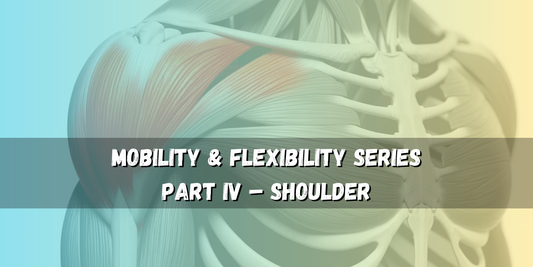Your upper back (thoracic spine) is the bridge between your lower body and upper body—and it plays a huge role in everything from tackling and passing to sprinting and absorbing contact. If your thoracic spine is tight or restricted, other areas like your shoulders, lower back, and neck are forced to compensate—leading to pain, poor posture, and reduced performance.
In Part 3 of our Mobility & Flexibility Series, we’re diving into thoracic mobility and why unlocking this area is essential for efficient movement, rotational power, and injury prevention.
Check out the rest of the series:
-
Part 1: Hip Mobility – Unlock Power & Stability
- Part 2: Ankle Mobility – Boost Speed & Agility
- Part 4: Shoulder Mobility – Maximize Range & Strength
- Part 5: Neck Mobility – Absorb Force & Protect Your Spine
- Part 6: Wrist Mobility – Grip, Dexterity & Contact Readiness
Let’s dive in.
WHAT IS THORACIC MOBILITY?
Thoracic mobility refers to your ability to rotate, extend, and flex your upper back (thoracic spine) freely.
Unlike the lower back (which should be stable), your thoracic spine is designed for rotation, extension, and flexion—all crucial for rugby players.
A mobile thoracic spine allows you to:
- Generate more power in passing, tackling, and rucking
- Rotate efficiently when stepping, sidestepping, and changing direction
- Absorb impact properly to prevent lower back and shoulder injuries
- Improve breathing and posture, leading to better endurance and recovery
But when thoracic mobility is restricted, your body compensates—leading to stiff shoulders, poor rotation, lower back strain, and inefficient movement.
THE THORACIC SPINE—WHY IT’S CRITICAL FOR RUGBY
Your thoracic spine isn’t just your upper back—it’s the bridge between your lower body and upper body, controlling how efficiently you move.
Several key muscle groups and structures affect thoracic mobility:
1. Thoracic Extensors (Upper Back Muscles)
- Role: Maintain upright posture and allow for proper spinal extension.
- When Tight or Weak? Leads to rounded shoulders, poor posture, and reduced power output.
2. Latissimus Dorsi (Lats)
- Role: Controls arm movement, impacts spinal mobility, and affects power generation in tackles.
- When Tight or Weak? Limits overhead movement, causing compensation in the shoulders and lower back.
3. Rotator Cuff Muscles
- Role: Stabilize the shoulder joint, allowing for smooth upper body rotation.
- When Tight or Weak? Leads to shoulder injuries and reduced passing accuracy.
4. Obliques & Core Muscles
- Role: Work with the thoracic spine to rotate the torso and generate power.
- When Tight or Weak? Reduces rotational strength, affecting passing, tackling, and sidestepping.
5. Diaphragm (Primary Breathing Muscle)
- Role: The diaphragm is the primary muscle responsible for breathing. It works closely with the thoracic spine and core muscles to maintain stability and generate intra-abdominal pressure.
- When Dysfunctional? Poor diaphragm function leads to shallow breathing, reduced endurance, and compensatory tension in the neck, shoulders, and lower back. This can also negatively impact spinal alignment and mobility.
WHY THORACIC MOBILITY MATTERS FOR RUGBY PERFORMANCE
1. More Explosive Tackles & Offloads
A mobile upper back lets you rotate and extend properly when tackling or passing, generating more force and precision.
2. Better Agility & Evasion
Quick sidesteps and direction changes require full thoracic rotation. If you’re stiff, your cuts and movements become slow and inefficient.
3. Injury Prevention (Lower Back, Shoulders, & Neck)
Poor thoracic mobility forces other areas (like the lower back and shoulders) to overcompensate, leading to chronic pain and injuries such as:
- Lower back strains from excessive lumbar flexion.
- Shoulder impingements due to restricted overhead movement.
- Neck pain from poor posture and excessive compensation.
THE CHAIN REACTION: HOW POOR THORACIC MOBILITY CAUSES INJURIES
When your thoracic spine is stiff, your body compensates in harmful ways:
- Restricted Thoracic Rotation → Overuse of Lower Back → Back Pain & Injuries
- Tight Lats & Upper Back → Shoulder Compensation → Shoulder Impingements & Rotator Cuff Injuries
- Poor Posture (Rounded Shoulders) → Weak Core & Imbalances → Increased Risk of Concussions & Neck Pain
Modern lifestyle habits—sitting too much, looking down at phones, and poor posture—worsen thoracic stiffness. If left unaddressed, these issues lead to pain and poor rugby performance.
THE THORACIC MOBILITY ROUTINE EVERY RUGBY PLAYER NEEDS
You can unlock your thoracic mobility in just 10-15 minutes a day.
This three-step process combines foam rolling, stretching and strengthening to free up your upper back and improve movement.
Step 1: Foam Rolling (3-5 Minutes)
-
Goal: Loosen tight muscles and increase blood flow.
- Muscles: Upper Back, Lats, Traps, Thoracic Spine
Step 2: Stretching & Mobility Drills (5-10 Minutes)
- Goal: Unlock thoracic rotation and extension for better movement.
- Exercises: Open Book Stretch, Cat-Cow Mobilization, Thoracic Extension & Rotations on Foam Roller.
Step 3: Make It a Daily Habit
Thoracic mobility work isn’t optional—it’s a key part of rugby preparation.
- Before Training: Use mobility drills as part of your warm-up.
- After Training: Stretch & foam roll to prevent stiffness.
- On Rest Days: Do extra work on tight areas.
WATCH THE FULL ROUTINE
We’ve put together the full routine on our YouTube channel to guide you through these foam rolling, stretching, and activation exercises.
Check out the Thoracic Mobility Routine below:
FINAL THOUGHTS
Thoracic mobility doesn’t get much attention—but it’s one of the most important pieces in the movement chain for rugby players. Unlocking your upper back can lead to:
- More powerful passes and tackles
- Better rotation and sidestepping
- Fewer injuries to your back, neck, and shoulders
Start today. Your spine (and your performance) will thank you.
Need More Help?
Check out our Rugby Workout Plans and Customized Training Programs to build a stronger, more resilient body.
This wraps up Part 3 of our Mobility & Flexibility Series: Thoracic Mobility. If you found this post helpful, make sure to:
- Like and share this post with fellow rugby players
- Bookmark the blog to stay updated on the next parts of the series
-
Follow Peak Rugby on X, Facebook and subscribe to the YouTube Channel for more rugby-specific training, mobility, and recovery tips.
Stay strong, keep pushing forward, and keep working on your mobility!















